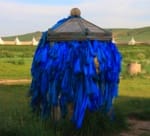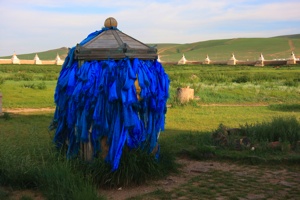The space of Mongolia, roughly three times the size of France, follows the curvature of the earth across thousands of kilometers from east to west, forming a vast horizon. This majestic environment, dominated by the Altai Mountains in the West, features wooded plateaus, grassy steppes, and arid deserts. From north to south, there are neither cultivated fields nor rice paddies, no fields clinging to the mountain sides nor hedges bordering estates: just boundless expanses, verdant steppes or those gnawed by deserts. On these lands, nomadic herders live, perhaps descendants of peoples who abandoned agricultural culture early on, as neither the soil nor the climate of the country are particularly favorable to it. For a long time, such activity was almost non-existent, except in the last centuries for the needs of the lamaseries or Chinese settlers. Livestock breeding, which has always predominated, still determines today a way of life, traditions, and original customs.
Currently, twenty-nine ethnic groups coexist in Mongolia, descendants of Turkic-Mongol nomadic tribes. The country is predominantly populated by Khalkh Mongols, with Kazakhs in the west and Buryats in the north being the other significant groups.
The core of this culture remains the family, gathered under the yurt or ger in Mongolian, a common term used to describe this unique felt tent. It has been the traditional dwelling of the steppe herders since time immemorial. Despite not being fixed to the ground, it withstands strong winds; remains cool in summer and warm in winter despite thin felt and textile walls. Quickly erected or dismantled, the interior organization is identical everywhere in the country: the entrance faces south, the men’s place is on the west, the north hosts distinguished guests or the elderly as well as the family altar, women’s place remains on the east while a stove occupies the center. Nomadic families often include multiple gers and
move at least twice a year, in spring in May and at the beginning of winter in October. These movements generally cover no more than a hundred kilometers, although larger movements are sometimes necessary to find better pastures. Life still revolves around an economy based on animal resources, led primarily by horses, domesticated very early in these endless prairies. Traditionally, nomads raise the so-called ‘Five Snouts’: horses, cows or yaks, sheep, goats, and camels. Reindeer are also used by the Tsaatan people on the fringes of Siberia, to the west of Lake Khovsgol. Winter camps are located in areas sheltered from the wind, and now a protective stable is readily used. The vicissitudes of nomadic life require constant meteorological observation, with forecasts clinging to the state of the sky, the stars, the winds, the mists, the echoes, the behavior of the animals…
The number of nomads has significantly decreased in recent years, and it is uncertain for how long this pastoral nomadism and its specific culture will be able to withstand the allure of modern urban life comforts and the phenomena of cultural globalization in general.



